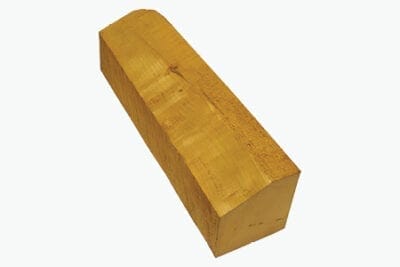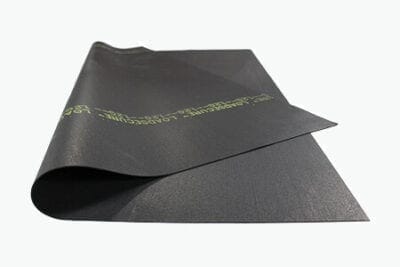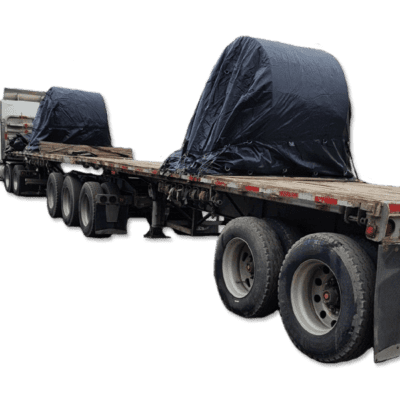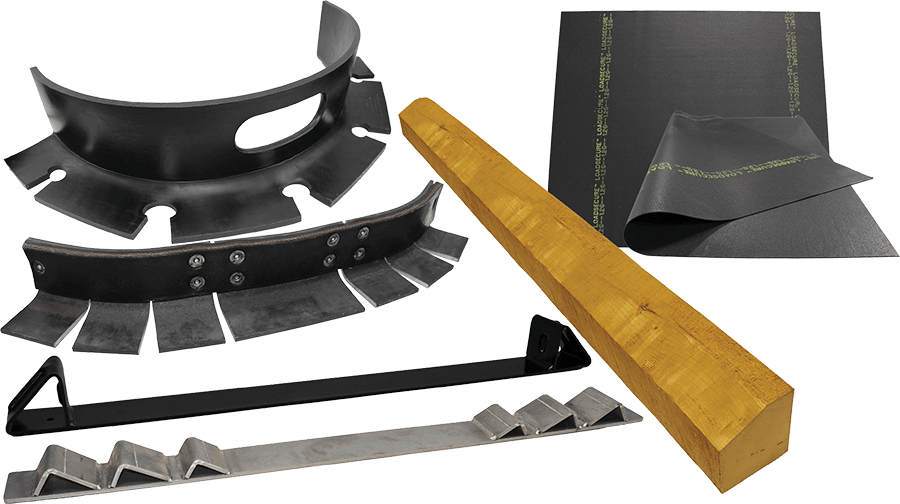When you first get into the business of hauling steel coils or, “Haulin’ Coil”, it is important that you have the tools of the trade to get the job done. With the proper tools and equipment you will be ready to make money, and that’s the name of the game isn’t it?
Listed below are the necessary tools and equipment conveniently available at the Verduyn Tarps closest to you.
For a strong foundation, let’s start from the deck up:
Coil Bunks:
At Verduyn Tarps we carry multiple different options of Coil bunks.
Available in both light and heavy duty are our most popular 3” Coil Bunks. These Coil bunks do not have a rating with the choice of light or heavy duty left to the driver. Both of these options work with beveled wood.
As a third option, our Canadian locations carry a 3” beveled bunk. This is a popular option for those who choose to carry square 4”x 4” wood.
Wood:
Next up is the wood, hard wood that is.

What type of wood you choose is dependent on what type of Coil Bunks you carry. If you choose to carry the light duty or heavy duty 3” bunks, we have a variety of beveled wood for you on both sides of the border:
Available in Canada:
- 4”x 4” x 4’
- 4” x 4” x 6’
- 4” x 4” x 8’
Available in USA:
- 4” x 4” x 6’
- 4” x 6’ x 6’
- 6” x 6” x 6’
If you use the beveled bunks our Canadian facilities carry 8’ square lumber as well.
Afraid of losing deck space? Take a peak at our Lumber carrier options.
Cargo Restraint Mat:
To comply with the NACSS (North American Cargo Securement Standard) all metal coils need a Load grip of 0.8 COF (Coefficient of Friction) or higher.
At Verduyn Tarps both the light duty and Heavy duty friction mats have a COF rating of .95 or higher. This rating is written right there on the mat to keep the MTO off your back.

Think this isn’t important?
It has been proven that any impact over 2.5 MPH can cause a load to shift. Therefore, follow the law and the old saying, “Better safe than sorry.”
Cuffs:
Lastly, the coil cuff.
Now that the coil is sitting between the lumber it is time to secure the load. When securing the load it is important not to damage the steel.
Here at Verduyn Tarps we have a two coil cuffs to choose from.
First is the plastic cuff. Weighing in at only 2.5 lbs. this a favorite among drivers looking to shave a few pounds at the scale.
Also available is the Steel cuff that is backed with rubber. This is a heavier option, but will last much longer.
Ready to shop? Why wait, click here to see our coil hauling inventory.
Want to see the parts yourself? Please call or come visit one of our Canadian locations to speak with our knowledgeable and friendly staff.
Additional Equipment:
Firstly, binders and chains are absolutely necessary to haul all coils. Once you know what working load limit you need we will be happy to provide the chains and binders that best suit you! Please browse our selection of chains and binders.
Worried about the weather? No problem, we are committed to serving as a one stop shop for all flatbed needs. Take a look at our Verduyn Coil bag.

Direct vs. Indirect Tie-Down
Direct and indirect tie-down is more than just terms used in the cargo industry. It is essential to know the difference as they are vital for load security, compliance, and safety. Using the right tie-down is necessary for meeting North American Cargo Securement Standards (NACSS) regulations.
Direct tie-downs are intended for securing a chain or a strap. It is attached directly to the cargo to limit movement by firmly securing the coil to the trailer.
Indirect tie-downs are anchored to both sides of the trailer and applied around the cargo. This method is still effective, but it relies heavily on friction between the deck and the cargo. In this setup, adding friction mats with a high COF (Coefficient of Friction) rating is important.
Each method has its own merits. Direct tie-downs are suitable for heavier coils or in situations where greater lateral movement is often encountered. Indirect tie-downs are used for loads that produce less shifting potential because they are much quicker to apply than direct tie-downs. Regardless of the method used, NACSS sets minimum requirements for the number of tie downs and their working load limits.
Additional Accessories Make The Difference
While wood, coil bunks, coil cuffs, and friction mats ensure compliance, additional accessories make the setup exceptional.
Binders and Chains
A Coil load needs proper binders and chains to keep cargo secure by keeping them firmly in place during transit. At Verduyn Tarps, we have a wide variety of grade 70 and grade 80 chains available in multiple lengths and thickness to meet Working Load Limit (WLL) requirements. When paired with lever binders or ratchets, truckers can achieve maximum control and tension.
Coil Bags
Protecting loads from harsh elements is necessary. Steel haulers are prone to moisture, making coil bags a great addition to the set.
Our 6′ x 6′ x 6′ Heavy Duty Coil Bag is the perfect protection from snow, rain, and dust. It is made with weather-resistant material with reinforced seams providing greater peace of mind even during the harshest conditions.
Compliance with Regulations
There is a good reason for heavily regulating steel coil: safety. North American Cargo Securement Standards (NACSS) ensure responsible hauling.
Verduyn Tarps makes compliance simple. We have friction mats rated at 0.95 COF or higher, whereas the minimum required is 0.8.
Binders and chains have also been rated and tested to comply with working load limits.
Weather Conditions
Weather can be unpredictable and the only way to protect cargo is to keep weatherproof tarps, rust-resistant steel cuffs, and coil bags ready. Aside from these accessories, there are also lumber carriers that can help store gear safety, keeping it dry and accessible when not in use.
Training and Experience
Having the best equipment is not enough because training is also important to ensure proper loading, positioning, and securing of steel coils. Verduyn Tarps provides walk-throughs for new haulers sharing best practices and strategies.
If there are regulatory changes or innovations, we work with experienced drivers to keep them informed. We believe that operating our equipment should also involve knowing how and when to use it correctly.
Finally, If you have any questions please feel free to visit any of our Canadian locations to speak with our knowledgeable and friendly staff.
Note: This expanded blog post incorporates information from the original article and adds detailed insights into equipment, securement methods, and considerations specific to Canadian truckers. For further information or to purchase equipment, please visit Verduyn Tarps.

